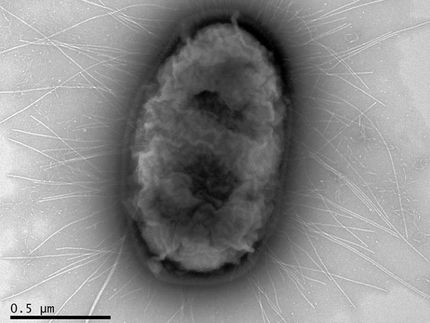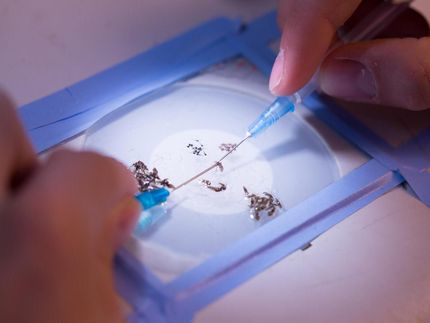Antibiotics for the prevention of malaria
Antibiotic treatment during the liver stage of malaria generates strong protective immunity
If mice are administered an antibiotic for three days and are simultaneously infected with malaria, no parasites appear in the blood and the life-threatening disease is averted. In addition, the animals treated in this manner also develop robust, long-term immunity against subsequent infections. This discovery was made by the team headed by Dr. Steffen Borrmann from the Department of infectious diseases at Heidelberg University Hospital in cooperation with Dr. Kai Matuschewski of the Max Planck Institute for Infection biology in Berlin. The scientists think that safe and affordable prophylaxis with antibiotics in residents of areas with high malaria transmission has the potential to be used as a natural "needle-free" vaccination against malaria.

A Plasmodium sporozoite (infectious stage of the malaria parasite transmitted by mosquito bite) entering the first host cell in the human body, i.e. the liver cell.
Max Planck Institute for Infection Biology / Brinkmann
Malaria is still the most common and most dangerous vector-borne disease. The World Health Organization (WHO) estimates that a million people die of malaria each year, especially children in African countries. Globally, over three billion people are at risk of being infected with malaria. There is still no medicine that reliably protects people from infection and simultaneously promotes building up long-term immunity.
Mice in the model had full protection
The scientists developed the following immunization model on mice. Sporozoites (infectious stage of malaria parasites transmitted by mosquitoes) were injected directly into the animals’ blood. At the same time, mice were treated with the antibiotics clindamycin or azithromycin. Normally, the sporozoites enter the liver, where they replicate massively and mature to the disease-causing blood stage forms (merozoites). The medication did not slow down the maturing of the merozoites in liver cells, but they prevented the red corpuscles in the blood from becoming infected. The typical disease symptoms such as fever and if left untreated, fatal malaria, which are caused solely by the blood stage forms of the parasite, did not occur. The parasites that accumulated in the liver gave the immune system sufficient stimulus to develop robust, long-term immunity. After 40 days, four months, and six months, the researchers again infected the mice with sporozoites, this time without adding antibiotics. All animals had complete protection against malaria.
Transferability to humans
This of course raises the question of whether these results can be transferred to humans. Under field conditions, mosquito bites confront the human body with frequent, but rather low concentrations of parasites. When mimicking this infection mode in the mouse model, 30 percent of the mice were still protected. For 85 percent of the mice that were still infected, the malaria did not affect the brain, indicating a favorable prognosis.
"The antibiotics used are reasonably priced medicines with few and self-limiting side effects. The periodic, prophylactic administration of antibiotics to people in malaria regions has the potential to be used as a "needle-free", natural vaccination. This would give us an additional powerful tool against malaria," says Dr. Steffen Borrmann. Dr. Kai Matuschewski adds, "A major motivation for our study was to test a simple concept that can also be realized in malaria regions. We are convinced that weakened parasites offer the best protection against a complex parasitical disease such as malaria."
New options for future medicines
The antibiotics administered target the apicoplast of the parasites. That is a small cellular organ of bacterial origin that the parasites need to penetrate other cells of the host organism. But since the medication blocking the apicoplast does not prevent the sporozoites from reproducing in the liver cell, the immune system is exposed to the full antigen load of a natural infection. This is not the case for previously developed vaccines with radiated or genetically modified malaria pathogens. "Even if our results cannot be confirmed in a field trial, the apicoplast is a promising target for future medication," explains Dr. Johannes Friesen of the Max Planck Institute for Infection Biology.
Original publication: Johannes Friesen, Olivier Silvie, Elyzana Dewi Putrianti, Julius C.R. Hafalla, Kai Matuschewski, Steffen Borrmann; "Natural Immunization against Malaria: Causal Prophylaxis with Antibiotics"; Science Translational Medicine, 2010, Online Publication, 14 July 2010




















































